OGC Nice got their 2020/21 Ligue 1 campaign off to a positive start on Sunday as they managed to earn a 2-1 victory over newly-promoted RC Lens.
Nice ended 2019/20 season in fifth place on the Ligue 1 table, while Lens ended last term as the second-placed side in France’s second-tier, however, this game was anything but a formality and after going behind in the 11th minute of the match, Nice had to wait until the 75th minute to finally get themselves in the lead.
In this tactical analysis piece, we will look at the tactics that were deployed by both of these two sides in Sunday’s Ligue 1 clash and provide analysis of how the two teams’ respective tactical set-ups influenced this game. We will look at how newly-promoted Lens caused Nice problems throughout the game, both on and off the ball, and we will look at the tactics that helped Les Aiglons to ultimately find a way to limit Lens to just one goal while scoring two of their own and taking all three points.
Lineups and formations
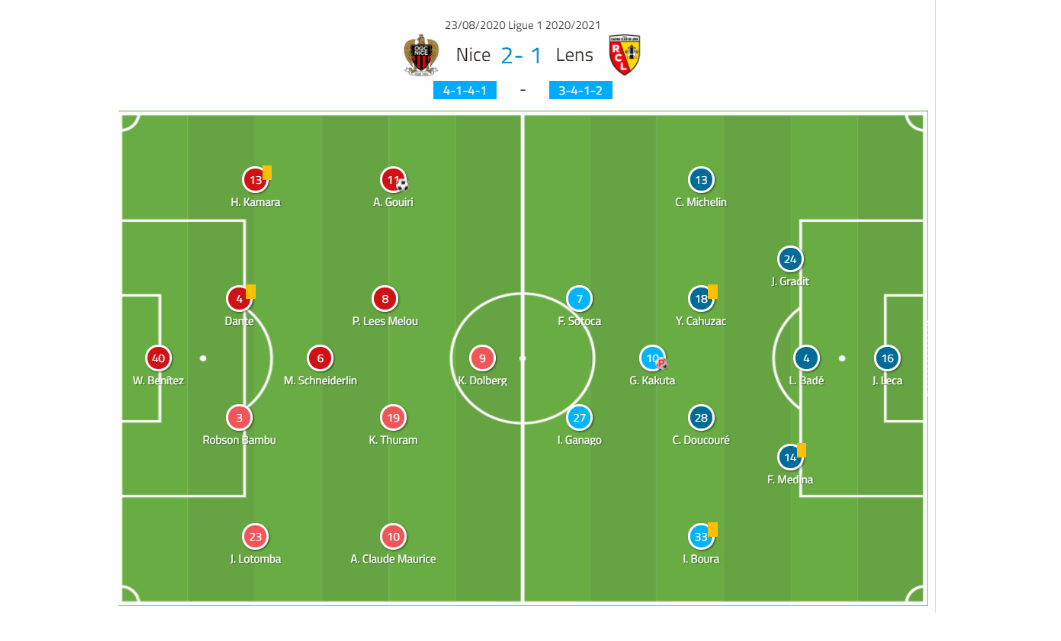
This game took place at Allianz Riviera and Patrick Vieira lined the home side up in a 4-1-4-1 shape for the fixture, which often became a 4-3-3 when Lens were in possession of the ball deep in their own half.
Walter Benítez started between the sticks for Nice in this one, while veteran Dante and three new signings, in the form of right-back Jordan Lotomba, left-back Hassane Kamara and Dante’s central defensive partner Robson Bambu started in Nice’s backline.
Another of Les Aiglons’ summer signings – former Everton, Manchester United and Southampton midfielder Morgan Schneiderlin, occupied the holding midfield position for Nice throughout this game, while Pierre Lees-Melou and Khéphren Thuram made up the rest of Nice’s central midfield.
Alexis Claude-Maurice and Amine Gouiri started on the wings for Les Aiglons and former Ajax forward Kasper Dolberg started up front for Vieira’s side.
Meanwhile, the away side lined up in a 3-4-1-2 formation for this contest. Jean-Louis Leca started in goal for Lens at Allianz Riviera, while Jonathan Gradit, Loïc Badé and Facundo Medina started at centre-back for Franck Haise’s team.
Clément Michelin and Ismaël Boura started at right and left wing-back respectively, while Cheick Doucouré and Yannick Cahuzac partnered each other in central midfield.
Finally, Lens goalscorer Gaël Kakuta played in the attacking midfield role just behind the centre forward pairing of Florian Sotoca and former Nice striker Ignatius Ganago.
Lens out of possession
To kick off this tactical analysis piece, we will take a look at Lens’ tactics when playing without the ball in this fixture. Lens were effective at preventing Nice from building attacks in this game. The fact that Lens took 16 shots at goal in Sunday’s fixture to Nice’s four shows that the home side struggled to create chances and Lens’ high press played a pivotal role in ending Les Aiglons’ attacks early time and again throughout this contest and ultimately limiting the number of attempts at goal that they managed by a significant amount.
While Nice came away from this fixture with a 2-1 victory, the scoreline does not tell the whole story of this game. Les Aiglons actually had an xG (expected goals) of just 0.18 versus Lens, while the away side had an xG of 3.04.
We will discuss other elements of these two teams’ tactics that contributed to these statistics later on in this tactical analysis, however, at present, we will discuss how Lens’ defensive tactics impacted the flow of this game.
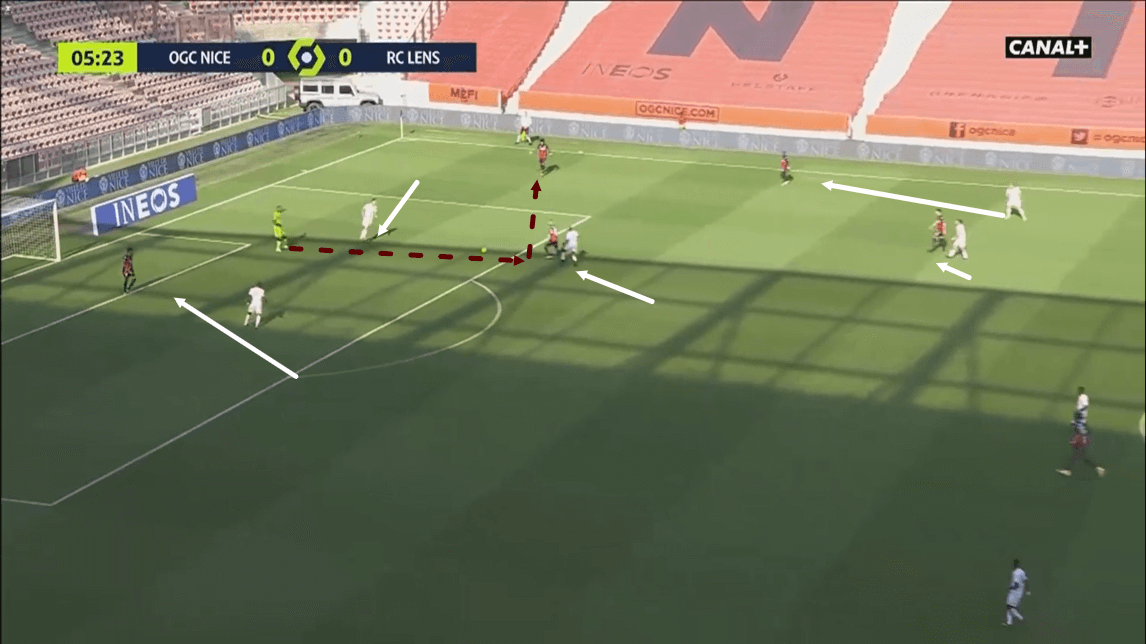
As mentioned above, Lens opted to defend high up the pitch versus Nice, who wanted to try and build their attacks patiently out from the back. The above image provides us with one example of Lens putting Nice into a difficult scenario during last weekend’s fixture.
Here, we can see Benítez passing the ball out to the player positioned directly in front of him. This was essentially the only short pass that the Argentinian stopper could have made here due to Lens’ effective pressing. The away side left the passing lane to this player open, however, there is still one player closely marking him from behind and the ball receiver is prevented from being able to turn, once he receives possession.
Due to the positioning of Lens’ players, the obvious pass for this player to make is back out to Dante, who we can see occupying the left-back position. As he receives the ball, the rest of Lens’ team organise themselves accordingly and actually manage to block off all of the Brazilian’s near passing options, creating a difficult scenario for Les Aiglons to have to try and play through.
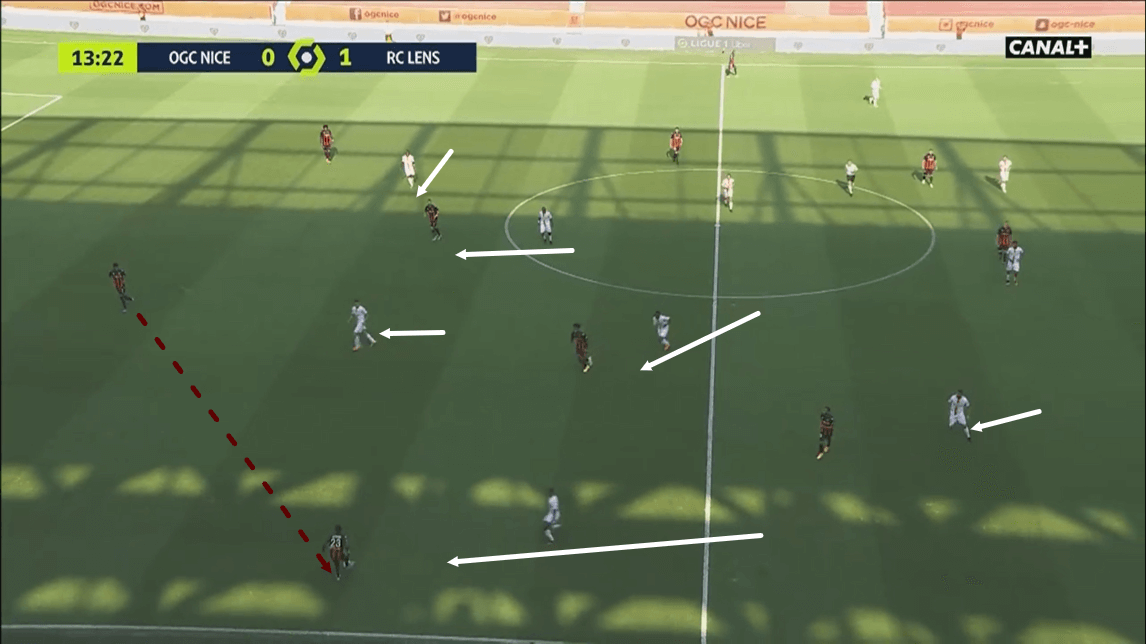
This next image shows us an example of Lens’ pressing in action in the middle third of the pitch versus Nice, however, this image also provides us with a larger view of the pitch and how Lens’ team are positioned.
We can see that Haise has got his players set up in order to block off Nice’s hopes of playing simple short passes through the middle of the pitch and Lens were very effective at doing that throughout this game.
Additionally, this meant that Lens would be forced to play through the full-backs or try a riskier pass.
On this occasion, we can see that Les Aiglons opted to play through the right-back and as he receives the ball, he immediately attracts attention from Lens’ left wing-back. Furthermore, the away side’s midfielders and near-side centre forward can also be seen shifting their positioning over this side of the pitch in order to limit the ball-carrier’s options.
The Nice right-back is unable to take the approaching left wing-back on one-on-one via a dribble and with all of the nearest progressive short passing options essentially unavailable here, the player is forced to play the ball backwards, indicating the effectiveness of a well-organised press.
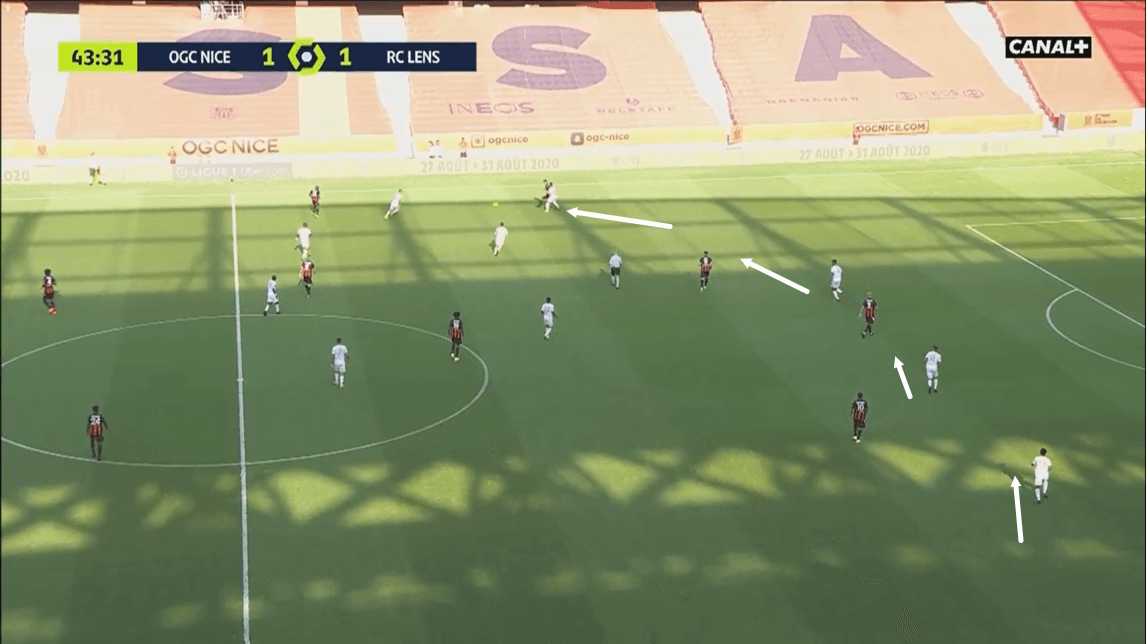
On occasions when Nice did progress to Lens’ final third, the away side defended with a well-organised five-man backline. The wing-back would push up to close down the opposition full-back and then the near-sided centre-back also shifted over to the wing to close down the winger. The rest of the defence would ultimately follow suit, shifting to that side of the pitch and adjusting their positioning accordingly.
However, Lens defended higher up the pitch far more frequently in this game and for the most part, they were undoubtedly quite effective at doing so.
Nice out of possession
While they struggled to build past Lens’ high press quite often throughout this fixture, losing the ball under pressure on various occasions to the away side, Nice’s patient, short passing-focused build-up did ultimately result in the home side keeping more possession of the ball than Lens in this one.
We will analyse Nice’s tactics in possession to a greater extent later on this tactical analysis piece, however for now, we’re going to look at how Vieira’s side set up defensively for their opening game of the new league season.
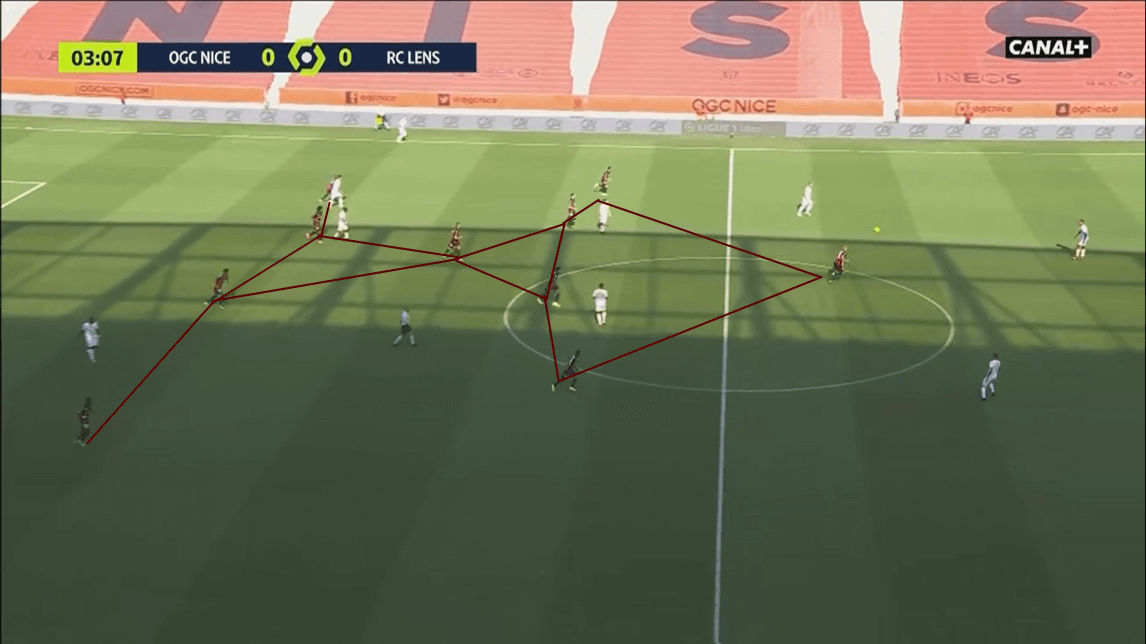
As we touched on above, back in the ‘lineups and formations’ section of this tactical analysis piece, Nice set up in a 4-1-4-1 shape in this fixture and we can see this shape in action during this contest in the image above.
Here, we can see Nice defending in the middle third of the pitch, while Lens attempt to break into the final third via their central defenders. What is most evident from this image of Les Aiglons’ defensive tactics is that they are defending in quite a compact and narrow shape, prioritising the protection of the central zones, but leaving plenty of space out on the wings.
However, all going to plan, Nice’s wingers would be able to block off the passing lanes from the centre-backs to the wing-backs, so that this pathway to the wide area, in which there is more space, would not be a viable one for them to take up.
Alternatively, Nice may even have been open to letting Lens play the ball out to the wide men in a deeper area of the pitch, however, in this particular image, we can see that a ball out to the wide man in space high up on the wing could result in Vieira’s side being put under immense pressure in the final third, and as a result, it was important for them to avoid that scenario.
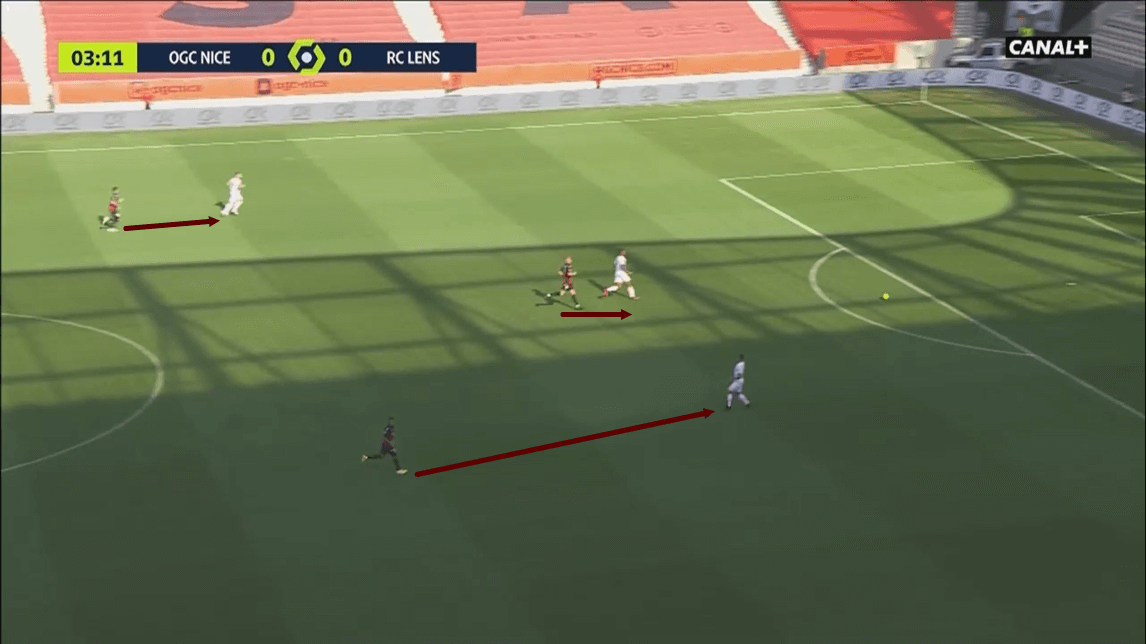
As this particular passage of play moves on, Nice forced Lens to play the ball backwards via their effective defensive block, and as Lens played the ball back into their own third, Nice’s two wingers quickly advanced their positions to form a 4-3-3, with one of the three front men man-marking one of the three Nice defenders at this stage of the game.
When Nice’s forwards advanced into this position, they became effective at preventing Lens from playing out short through the three central defenders and this often led to Lens playing the ball long, which could make it more difficult for them to retain possession while building their attacks.
Lens in possession
However, as we mentioned previously, contrary to the final scoreline of this game, Lens dominated Nice in terms of xG and this indicates that the away side did manage to create plenty of goalscoring chances in this fixture, meaning that they’ll have managed to find away to get around Nice’s defence.
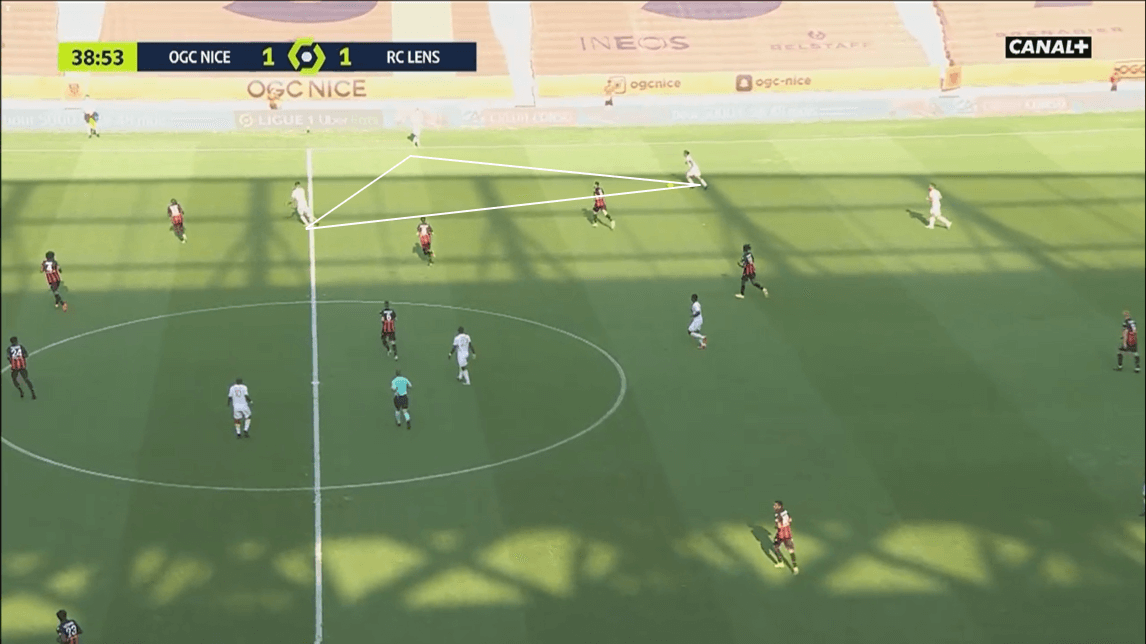
As we touched on, Lens did find some joy while building out into the wide areas, with the wing-back positioned in a slightly deeper area of the pitch. Here, we can see the Lens wing-back positioned just inside his own half, while the near-sided central defender and the near-sided centre forward position themselves near him to form a triangle on that wing.
Due to Nice’s focus on primarily defending the central areas of the pitch, Lens’ creation of this triangle out wide makes it difficult for the home side to defend against them and they can build an attack down that wing via the wing-back and centre forward, who can be seen positioning himself out wide to offer another progressive passing option for this wing-back to potentially link up with.
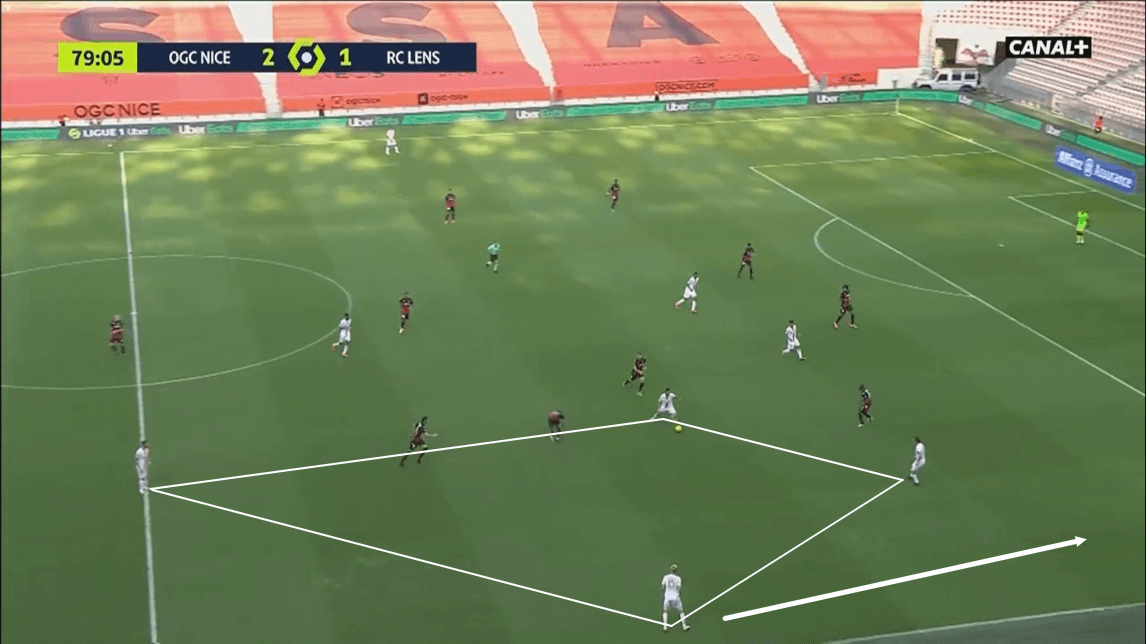
As the game wore on and Nice eventually ended up in the lead, that didn’t stop Lens from trying to utilise this tactic of building down the wings and overloading the wide areas in order to try and create goalscoring chances. This next image is taken from later on in the game and as we can see, the away side are building this attack in a similar fashion to how they built their attack in the previous image from the first half.
However, one difference here is that Nice, now leading by a goal, are defending slightly deeper and as a result, the Lens wing-back is able to situate himself higher on the pitch, making him even more of a direct attacking threat.
The Lens central midfielder manages to get himself on the ball, as we can see, and as he does so, the wing-back begins to make his run down the touchline into space, while the wide centre forward also advances his position. This attack, like many of the away side’s attacks in this fixture, ends up with Lens sending a cross into the box, however on this particular occasion, that cross ultimately didn’t lead to a shot that tested the goalkeeper, however, Lens’ ability to create goalscoring chances via their wing play and intelligent passing sequences out wide is evident from their performance in this game.
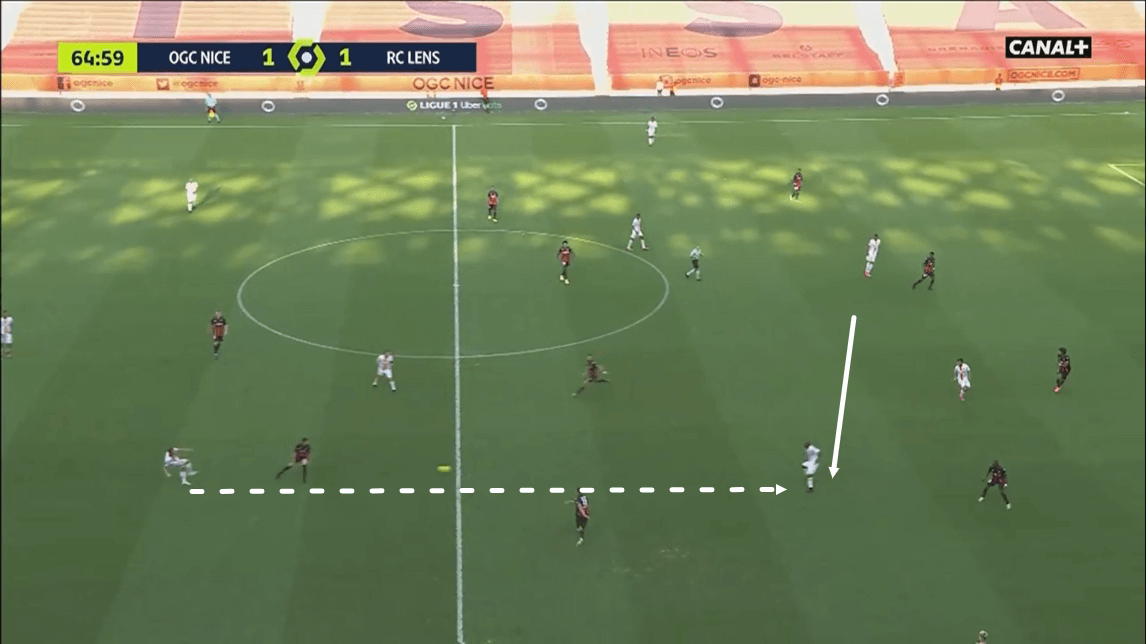
In general, while they liked to initially build their attacks via their backline in Sunday’s game, Lens appeared to be quite happy to get the ball directly into the feet of one of their two centre forwards, or their attacking midfielder, by the time they built the play up into the middle third of the pitch.
Once they reached the middle third of the pitch, Lens typically didn’t waste too much time before either attempting a long-ball or playing a direct, defence-splitting ball, like the one we can see them playing in this image above, into one of their three main central attackers’ feet.
This put a large amount of responsibility on these three attackers to contribute significantly to their team’s efforts in the final third via their movement and their link-up play with one another once the ball had been received. This resulted in Lens attempting plenty of quick, short passing plays between their three central attackers following a more direct ball from a slightly deeper position, like this one. This was another one of Haise’s side’s go-to tactics in possession of the ball, in this fixture.
Nice in possession
Lastly, we will discuss the tactics that the winning side, Nice, deployed in possession of the ball to help them score two goals and ultimately come away with all three points from Sunday’s fixture.
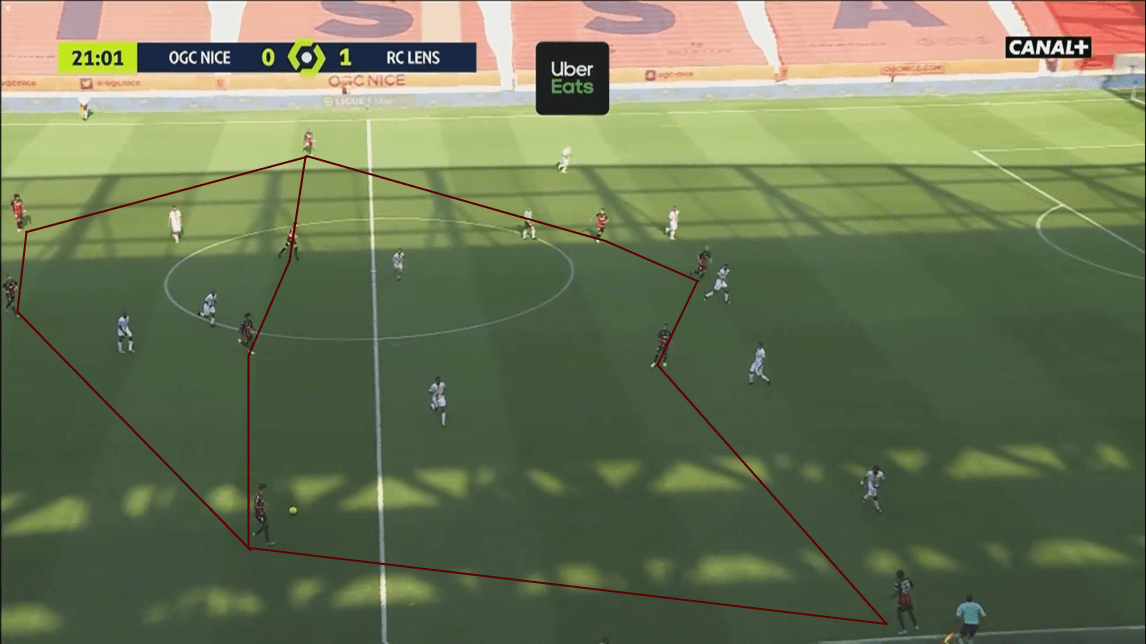
Firstly, this image above shows us an example of the shape that Nice typically utilised when in possession of the ball in last Sunday’s game. Schneiderlin often dropped deep in between the two central defenders, while the two full-backs advanced their position higher up the wings. The two wingers, Gouiri and Claude-Maurice, then sat narrower, essentially occupying this position just playing off either side of centre forward Dolberg.
This general offensive shape worked well for Nice in the end versus Lens last Sunday. Gouiri scored both of Les Aiglons goals thanks to Vieira’s decision to utilise him in this role. One goal came after a quick bit of link-up play with the overlapping left-back – Kamara, while the other goal came as a result of Nice winning the ball back high up the pitch thanks to their solid defensive shape, which we touched on earlier. The ball fell to Gouiri in his position in the left half-space and he capitalised on the ball recovery to score.
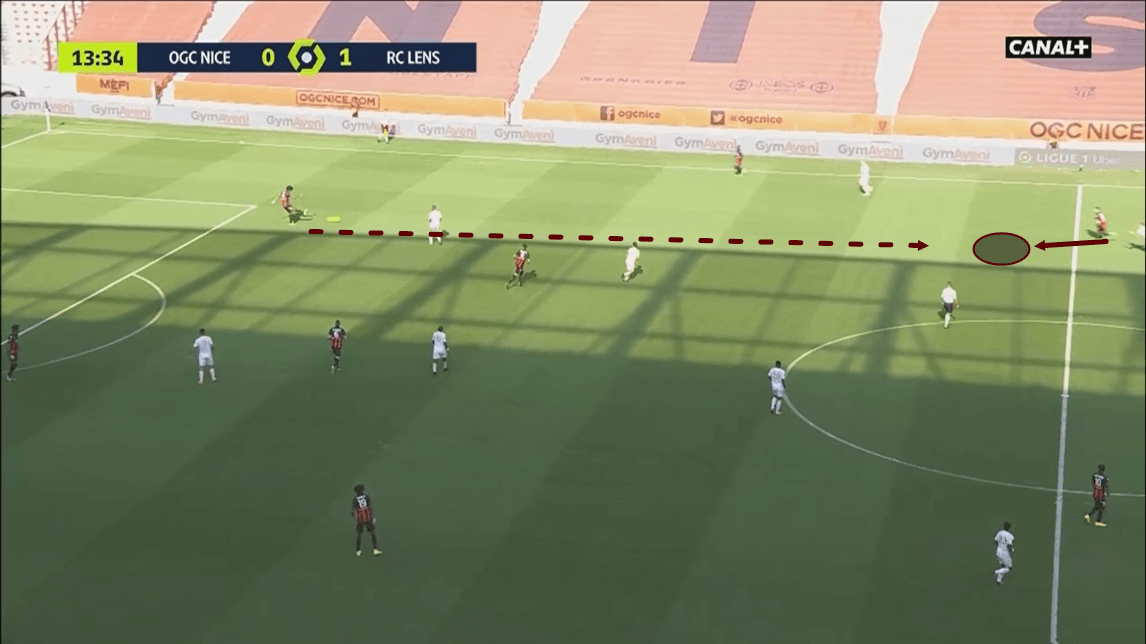
At the beginning of this tactical analysis, we spent some time talking about Lens’ aggressive press and its effectiveness at preventing Nice from building attacks, however, the home side did manage to beat this press on occasion, via some impressive and effective offensive tactics that they attempted to utilise throughout the fixture. One way that Nice effectively managed to beat the Lens press was a combination of the ball-playing ability of their central defenders and Schneiderlin and the movement of their wide men, in particular, Gouiri.
In the image above, we can see Lens pressing Nice high up the pitch, however, we can also see Dante on the ball here lining up a defence-splitting ball destined for winger Gouiri, who we can see moving from his position high on the left-wing, into the left half-space.
As the wide man moves into this position, he frees himself up to receive the ball without as much pressure and Dante is also able to find his run without too much trouble as this particular passing lane was not being covered at that point in time.
Gouiri, an excellent dribbler and a player with impressive technical attributes, could then control the ball and carry it forward or link up with another Nice attacker to cause the opposition trouble in the final third.
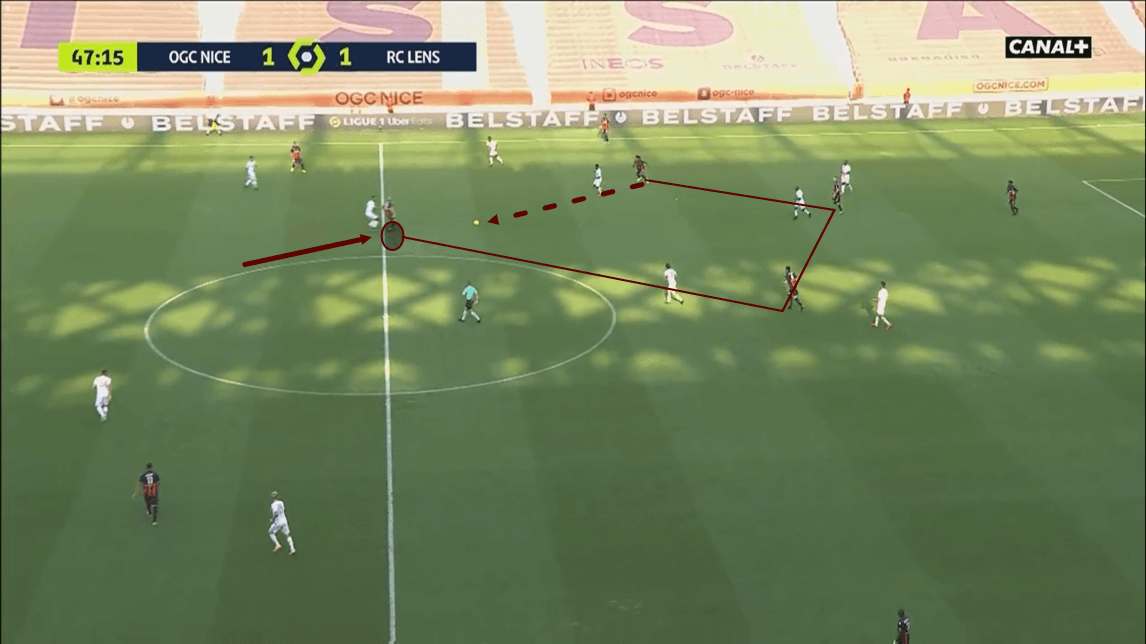
In addition to the wide men, Nice’s centre forward Dolberg also frequently dropped deep, essentially creating a diamond in central midfield, in order to offer his side a free progressive passing option at times in this fixture.
Dolberg excels in this role thanks to his movement and his impressive technical ability, which he can put to good use once he receives the ball.
Dolberg’s movement was effective at providing his teammates with a free progressive passing option, which they often didn’t hesitate to take advantage of, and at pulling opposition defenders out of position, as they would often follow him as he dropped deep, creating a hole in the opposition’s defensive line, in the process. One of Nice’s two wide men could then drift inside and run into the space that Dolberg created to cause problems for the opposition, while Dolberg himself could also take advantage of this space by quickly releasing the ball after receiving it to turn and move back into the central position.
Conclusion
To conclude this tactical analysis piece, it’s clear that both Lens and Nice utilised some impressive and effective tactics both on and off the ball in Sunday’s Ligue 1 2020/21 season opener.
Lens ultimately came up short despite creating better chances than Nice, judging by xG, however, Nice managed to create their chances for a more clinical player on the day, in Gouiri, and their effective utilisation of the former Lyon man proved to make all the difference.





Comments